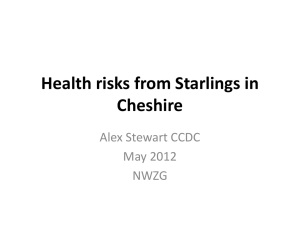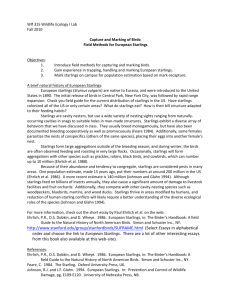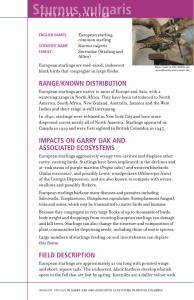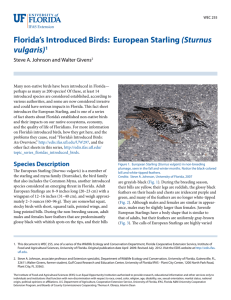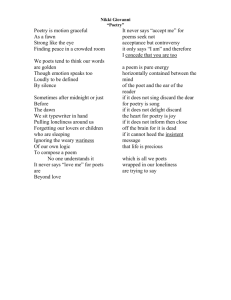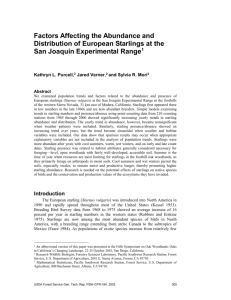European Starlings and Their Effect on Native Cavity
advertisement
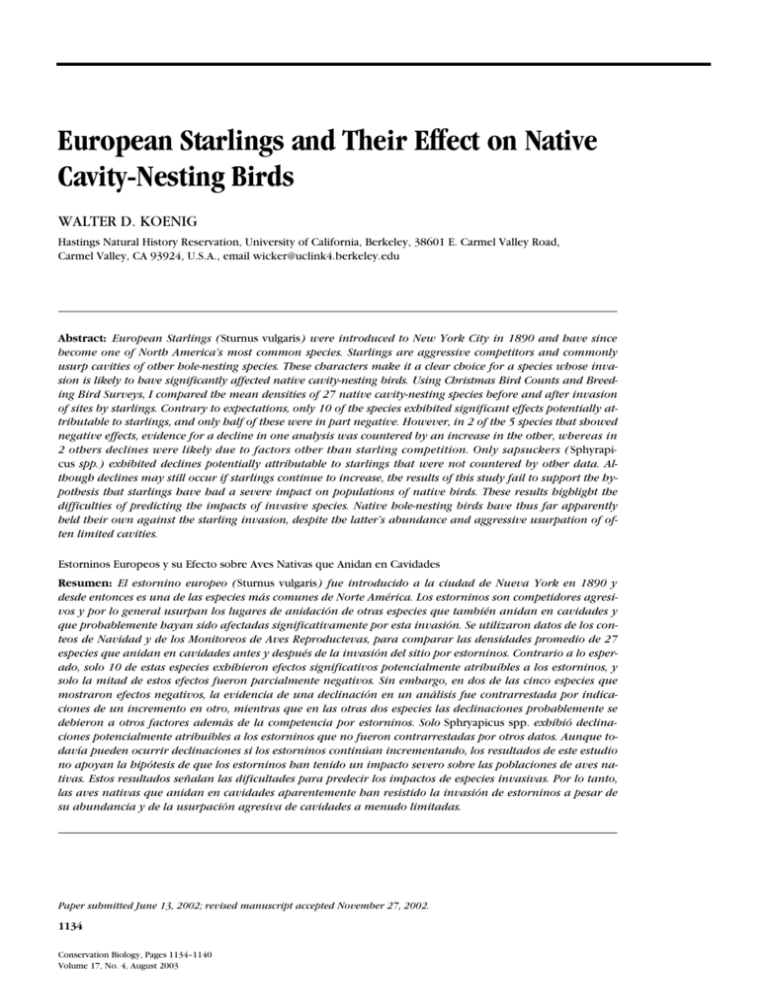
European Starlings and Their Effect on Native Cavity-Nesting Birds WALTER D. KOENIG Hastings Natural History Reservation, University of California, Berkeley, 38601 E. Carmel Valley Road, Carmel Valley, CA 93924, U.S.A., email wicker@uclink4.berkeley.edu Abstract: European Starlings ( Sturnus vulgaris ) were introduced to New York City in 1890 and have since become one of North America’s most common species. Starlings are aggressive competitors and commonly usurp cavities of other hole-nesting species. These characters make it a clear choice for a species whose invasion is likely to have significantly affected native cavity-nesting birds. Using Christmas Bird Counts and Breeding Bird Surveys, I compared the mean densities of 27 native cavity-nesting species before and after invasion of sites by starlings. Contrary to expectations, only 10 of the species exhibited significant effects potentially attributable to starlings, and only half of these were in part negative. However, in 2 of the 5 species that showed negative effects, evidence for a decline in one analysis was countered by an increase in the other, whereas in 2 others declines were likely due to factors other than starling competition. Only sapsuckers ( Sphyrapicus spp.) exhibited declines potentially attributable to starlings that were not countered by other data. Although declines may still occur if starlings continue to increase, the results of this study fail to support the hypothesis that starlings have had a severe impact on populations of native birds. These results highlight the difficulties of predicting the impacts of invasive species. Native hole-nesting birds have thus far apparently held their own against the starling invasion, despite the latter’s abundance and aggressive usurpation of often limited cavities. Estorninos Europeos y su Efecto sobre Aves Nativas que Anidan en Cavidades Resumen: El estornino europeo (Sturnus vulgaris) fue introducido a la ciudad de Nueva York en 1890 y desde entonces es una de las especies más comunes de Norte América. Los estorninos son competidores agresivos y por lo general usurpan los lugares de anidación de otras especies que también anidan en cavidades y que probablemente hayan sido afectadas significativamente por esta invasión. Se utilizaron datos de los conteos de Navidad y de los Monitoreos de Aves Reproductevas, para comparar las densidades promedio de 27 especies que anidan en cavidades antes y después de la invasión del sitio por estorninos. Contrario a lo esperado, solo 10 de estas especies exhibieron efectos significativos potencialmente atribuibles a los estorninos, y solo la mitad de estos efectos fueron parcialmente negativos. Sin embargo, en dos de las cinco especies que mostraron efectos negativos, la evidencia de una declinación en un análisis fue contrarrestada por indicaciones de un incremento en otro, mientras que en las otras dos especies las declinaciones probablemente se debieron a otros factores además de la competencia por estorninos. Solo Sphryapicus spp. exhibió declinaciones potencialmente atribuibles a los estorninos que no fueron contrarrestadas por otros datos. Aunque todavía pueden ocurrir declinaciones si los estorninos continúan incrementando, los resultados de este estudio no apoyan la hipótesis de que los estorninos han tenido un impacto severo sobre las poblaciones de aves nativas. Estos resultados señalan las dificultades para predecir los impactos de especies invasivas. Por lo tanto, las aves nativas que anidan en cavidades aparentemente han resistido la invasión de estorninos a pesar de su abundancia y de la usurpación agresiva de cavidades a menudo limitadas. Paper submitted June 13, 2002; revised manuscript accepted November 27, 2002. 1134 Conservation Biology, Pages 1134–1140 Volume 17, No. 4, August 2003 Koenig Introduction Predicting the impact of introduced species is a problem of considerable interest in conservation biology. The overall impact of an exotic species is determined by some combination of its range, abundance, and impact per individual (Parker et al. 1999). Meanwhile, there are a variety of levels at which an invader’s impact can be measured, including its effects on individuals, genetic effects such as hybridization, population dynamic effects, community effects, and effects on ecosystem processes. Assessment of the importance of any of these is challenging and, in lieu of experimental or carefully controlled comparisons, potentially misleading (Diamond & Veitch 1981; Williamson 2001). The European Starling ( Sturnus vulgaris ) in North America is one avian species whose adverse impacts would appear to be unambiguous. Starlings were introduced to New York City in 1890 and by the late 1940s had spread across much of the continent north of Mexico (Cabe 1993). They eat a wide variety of animal and plant material and have become one of the most conspicuous and abundant terrestrial birds in North America, with populations estimated nearly 20 years ago to be on the order of 2 108 individuals (Feare 1984). Thus, starlings rank at the upper end of the spectrum on at least two of the three impact factors discussed by Parker et al. (1999), range and population size. Observations of competition between starlings and native cavity-nesting species in North America date as far back as Kalmback and Gabrielson (1921). More recently, Lindell ( 1996, unpublished data ) found records of nest usurpation by starlings in seven North American woodpecker species. Kerpez and Smith ( 1990 ) found evidence for competition and a negative relationship between starlings and Gila Woodpeckers ( see Table 1 for scientific names ) nesting in saguaro cacti in Arizona. Weitzel ( 1988 ) presented data from a single site in Nevada where starlings apparently precluded the nesting of a series of native species. Zerhusen (1994) reported trapping and disposing of 406 starlings from a single bluebird nest box over a period of 7 years. In a particularly detailed study, Ingold (1996, 1998) found that starlings in Ohio forced a high proportion of Northern Flickers to delay breeding. Although pairs were ultimately successful, there was a significant seasonal decline in fecundity in the population, prompting Ingold ( 1998 ) to conclude “it is clear that European Starlings are having a significantly adverse effect on the reproductive success of Northern Flickers.” Drawing on such observations, Cabe (1993) concluded that the starling “has had a detrimental effect on many native cavity-nesting species.” Despite these clear examples of starling interference, several researchers have failed to demonstrate that starlings have negatively affected cavity-nesting species. Troetschler ( 1969, 1976 ), for example, documented Starlings and Cavity-Nesting Birds 1135 considerable competition for cavities between starlings and Acorn Woodpeckers in California but found no conclusive evidence for adverse effects on the latter. She attributed this to the Acorn Woodpeckers’ longer and more flexible breeding season, which allowed them to breed successfully after the starlings had finished. Ingold (1994) reached a similar conclusion for three species of woodpeckers competing with starlings in Ohio. These studies unambiguously demonstrate that aggressive competition for nest cavities by starlings can displace a variety of native species, forcing the latter to delay breeding within a season, if nothing else. Nonetheless, the demographic consequences of this competition for native species remain unclear. Here I draw upon nearly a century of data from Christmas Bird Counts (CBC) and 31 years of data from the North American Breeding Bird Survey (BBS) to determine whether starlings have caused declines of native cavity-nesting birds in North America. If so, measures to control starling populations or otherwise aid breeding of native cavity-nesting species may be necessary to maintain native species and preserve the complex structure of “nest web” communities ( Martin & Eadie 1999). If not, then starlings, despite their ability to usurp cavities and outcompete native species, may represent an invader that has been able to add itself to North American communities of birds without adversely affecting avian diversity. Methods I obtained data from Christmas Bird Counts ( CBC ) and Breeding Bird Surveys (BBS) on relative densities of European Starlings and on 27 taxa of North American cavity-nesting birds ( “target species”; Table 1 ). The BBS data consist of 3-minute censuses at a series of 50 stops 0.8 km apart along a road transect (Bystrack 1981); the data were available from 1966 to 1996. The CBC data consist of 1-day intensive surveys conducted within a 2-week period around Christmas and restricted to a specific 24-km-diameter circle; they were analyzed for all years from 1900 through 1996 ( Shipman 2000 ). I used files as they were given, except that I assumed counts that did not overlap in time and were within 3 minutes of both latitude and longitude were continuations and combined them. Species examined included all common North American woodpecker species and several secondary cavity-nesting species, including American Kestrels, several swallows, two flycatchers, and the three North American bluebirds. I combined data on Yellow-bellied, Red-breasted, and Red-naped sapsuckers and refer to them as “yellow-bellied” sapsuckers. For the BBS data, I used the log-transformed number of birds detected as an index of relative density. To control for varying effort in the CBC data, I determined the number of birds per party hour ( pph ) for all combina- Conservation Biology Volume 17, No. 4, August 2003 1136 Starlings and Cavity-Nesting Birds Koenig Table 1. Significance of changes in mean density of North American cavity-nesting birds at Christmas Bird Count (CBC) and Breeding Bird Survey (BBS) sites during invasion by European Starlings. Common name American Kestrel Lewis’ Woodpecker Red-headed Woodpecker Acorn Woodpecker Gila Woodpecker Golden-fronted Woodpecker Red-bellied Woodpecker Williamson’s Sapsucker “Yellow-bellied” sapsucker (Yellow-bellied, Red-breasted, and Red-naped combined) Ladder-backed Woodpecker Nuttall’s Woodpecker Downy Woodpecker Hairy Woodpecker Red-cockaded Woodpecker White-headed Woodpecker Three-toed Woodpecker Northern Flicker Gilded Flicker Pileated Woodpecker Ash-throated Flycatcher Great Crested Flycatcher Purple Martin Tree Swallow Violet-green Swallow Eastern Bluebird Western Bluebird Mountain Bluebird Apparent effect of starlings c Scientific name Typea CBC b BBS b Falco sparverius Melanerpes lewis Melanerpes erythrocephalus Melanerpes formicivorus Melanerpes uropygialis Melanerpes aurifrons Melanerpes carolinus Sphyrapicus thyroideus Sphyrapicus varius, S. nuchalis, and S. ruber S P P P P P P P P 17.8*** (34) 5.7 (12) 4.1 (13) 0.6 (24) 4.2 (3) 4.8 (2) 0.8 (25) 3.4 (8) 15.1** (54) 14.2** (72) 1.9 (7) 6.9 (43) 15.5*** (15) 2.1 (4) 4.0 (20) 17.9*** (40) 1.6 (6) 4.8 (31) positive/negative ns ns ns/positive ns ns ns/positive ns negative/ns Picoides scalaris Picoides nuttallii Picoides pubescens Picoides villosus Picoides borealis Picoides albolarvatus Picoides tridactylus Colaptes auratus Colaptes chysoides Dryocopus pileatus Myiarchus cinerascens Myiarchus crinitus Progne subis Tachycineta bicolor Tachycineta thalassina Sialia sialis Sialia mexicana Sialia currucoides P P P P P P P P P P S S S S S S S S 2.5 (14) 20.2*** (18) 6.8 (76) 3.5 (76) 8.5* (10) 2.0 (5) 1.5 (7) 9.6* (71) 1.2 (2) 4.0 (26) — — — — — 9.6* (20) 5.3 (22) 4.4 (32) 2.2 (44) 10.8* (6) 2.8 (60) 1.5 (49) 7.3 (4) 3.0 (7) — 2.7 (110) — 10.3* (38) 5.7 (53) 1.9 (57) 8.0* (66) 6.4 (42) 4.3 (35) 3.2 (103) 4.7 (33) 0.2 (33) ns positive/negative ns ns negative/ns ns ns Initially positive/ns ns ns/positive ns ns positive ns ns negative/ns ns ns a Abbreviations: S, secondary cavity-nesting species; P, primary cavity-nesting species. 32 from Friedman test (number of sites); *p 0.05; **p 0.01; ***p 0.001. For categories, see text. When no value is listed, the species could not be tested because of small sample size or because it is not present during the winter. Number of sites is in parentheses. c When two effects are listed, the first refers to the CBC and the second to the BBS analyses. b tions of species, site, and year. I then log-transformed ( log( x 1 ) ) the values ( x ) to normalize the distributions. As an alternative to this simple procedure, I also followed the methodology proposed by Link and Sauer ( 1999 ) and used a fixed-effort adjustment parameter ( p 1.5) and the residuals of a linear regression of effort on the ( log-transformed ) number of birds counted as an estimate of relative density. Results were unchanged from those based on birds per party hour. For each combination of species and site, I calculated the (log-transformed) relative densities recorded at that site for starlings and for the target native species for each year the survey was conducted. Next I determined the first year starlings were observed at the site (“first year”). In many cases, particularly with the BBS data, counts were initiated following invasion by starlings. These counts were excluded from the analyses. At the remaining sites, I calculated mean log-transformed density, dividing years into four categories: (1) the 5 years immediately preceding the first year ( pre ), ( 2 ) the 5 years starting with first year (post 1; years 0–4 post–first year), (3) the next 5 years (post 2; years 5–9 post–first year), and (4) all sub- Conservation Biology Volume 17, No. 4, August 2003 sequent years (post 3; years 10 post–first year). I used whatever years of data were available when fewer than 5 years were available in 1 or more of the first 3 categories, but at least 1 year of data (2 in the “pre” category to ensure that starlings had not been present previously) had to be available for all 4 categories for the site to be included. Also, I only included sites where the target species was detected during the “pre” (category 1) years. I used these arbitrary time periods as indices of the mean density of the target species immediately prior to first detection of starlings, immediately following invasion by starlings, and then during two subsequent periods while starlings presumably became an established part of the community. For each target species, I used Friedman tests for a significant difference among the four categories of years. Since CBC surveys are conducted during the winter, CBC data do not directly measure potential breeding interactions, especially for migratory species. Nonetheless, I included the CBC data because they provide good estimates of winter densities and would be likely to correlate with widespread population declines attributable to starling interference. Koenig Starlings and Cavity-Nesting Birds 1137 Results A total of 103 CBC and 158 BBS sites met the criteria for inclusion in the analyses. The CBC sites included in the analyses were invaded starting in the 1940s and continuing through the 1980s ( Fig. 1 ). In the BBS data, which starts in 1966 after starlings had already arrived at many sites, the majority of sites included in the analyses were colonized in the 1970s ( Fig. 1 ). Sites in all quarters of the country were represented, although because starlings were introduced in the northeastern United States and thus often present in this region prior to when surveys began, sites were not distributed geographically evenly (Fig. 2). Of the 27 species tested, 10 exhibited significant differences in abundance across the four periods in one or both of the analyses ( Table 1 ). Thus, no significant change in relative abundance over the course of invasion by starlings was detected in 17 ( 63% ) of the species. Significant differences in both the CBC and BBS analyses were detected for only 2 of 20 (10%) of the species for which both analyses could be conducted. Of the 10 species exhibiting significant differences in one or both analyses, only 5 (American Kestrel, “yellowbellied” sapsucker, Nuttall’s Woodpecker, Red-cockaded Woodpecker, and Eastern Bluebird ) exhibited significant declines that were potentially attributable to starlings (Fig. 3). However, for 2 of these species (American Kestrel and Nuttall’s Woodpecker) analyses were ambiguous in that significant declines in the BBS data were Figure 2. Distribution of sites used in the analyses. The four categories were delimited by dividing North America into geographic quartiles at 40 N latitude and 100 W longitude. countered by significant increases in the CBC data (Fig. 3). In the remaining 3 species, negative trends in the CBC data were paired with nonsignificant changes in the BBS data. For “yellow-bellied” sapsuckers, CBC values first increased and then fell below the “pre” values, significantly so ( p 0.002) in the CBC data. Densities of Redcockaded Woodpeckers also declined in both analyses, again significantly so ( p 0.04) in the CBC data. Eastern Bluebirds declined significantly ( p 0.02 ) in the CBC data but increased nonsignificantly in the BBS data. In contrast, four of the species exhibited significant increases over the course of the starling invasion. Three of these ( Acorn, Red-bellied, and Pileated woodpeckers ) increased significantly in the BBS data but not in the CBC data. The migratory Purple Martin increased significantly in the BBS data. The only other species to exhibit significant changes, the Northern Flicker, initially increased in abundance in the CBC data and then returned to within 2% of the “pre” value (Fig. 3). Discussion Figure 1. Distribution of years when European Starlings (Sturnus vulgaris) were first detected at the Christmas Bird Count and Breeding Bird Survey sites analyzed. Sites were included only if data were available for at least 2 years prior to first detection of starlings and for at least 1 year in each of the three categories (5 years following detection, the next 5 years, and all subsequent years) following detection of starlings. Of 27 taxa examined, only 10 ( 37% ) exhibited significant changes in mean population density following detection of starlings. However, at least as many of these increased rather than decreased following starling colonization, including Red-bellied Woodpeckers, one of the only species for which there exists good evidence of a high frequency of nest usurpation by starlings (between 39% and 52%; Ingold 1989, 1994). Only five (19%) species exhibited significant declines, none of which was significant in both data sets. Taken as a whole, these data fail to support the hypothesis that the North American starling invasion has severely affected native cavitynesting birds. Besides the lack of concordance between the results of the CBC and BBS data, there are other reasons to be Conservation Biology Volume 17, No. 4, August 2003 1138 Starlings and Cavity-Nesting Birds Koenig Figure 3. Mean densities (Christmas Bird Count [CBC]: log-transformed birds per party hour; Breeding Bird Survey [BBS]: log-transformed number of birds detected) before and after first detection of European Starlings for 10 bird species that exhibited significant changes over specific time periods (5 years prior to first detection of starlings [pre]; 5 years following detection [post 1]; the next 5 years [post 2], and all subsequent years [post 3]). Significance of differences over time periods: *p 0.05; **p 0.01; ***p 0.001. Each panel gives data for a different species. In several cases, the y-axis is divided to better represent the results of the two analyses. Even when not separated, however, the scales of the two surveys should not be considered comparable. Species codes: AMKE, American Kestrel; ACWO, Acorn Woodpecker; RBWO, Red-bellied Woodpecker; YBSA, Yellow-bellied, Redbreasted, and Red-naped sapsuckers combined; NUWO, Nuttall’s Woodpecker; RCWO, Red-cockaded Woodpecker; NOFL, Northern Flicker; PIWO, Pileated Woodpecker; PUMA, Purple Martin; and EABL, Eastern Bluebird. skeptical that the declines I detected are attributable to starlings. American Kestrels, for example, are 50% larger than starlings and are thus unlikely to be victims of starling nest usurpation. Conversely, Nuttall’s Woodpeckers build cavities smaller than starlings can use ( Miller & Bock 1972 ). And, despite considerable attention to interspecific encounters of this species by Short (1971), I am aware of only one reported case of starling interference with this species ( a mention by Lowther [2000] based on comments accompanying a census by Riensche and Cogswell [1993]). Thus, starlings are unlikely to be a significant problem for this species. As a secondary cavity-nesting species, Eastern Bluebirds are vulnerable to starling competition for nest cavities. Overall trends for this species in the BBS data were negative during the 1966–1979 period, but this has been attributed to severe winters and spring storms, not nestsite competition (Gowaty & Plissner 1998). In fact, over Conservation Biology Volume 17, No. 4, August 2003 the longer 1966–1993 period, trends in the BBS data were positive for this species (Gowaty & Plissner 1998). Similarly, Red-cockaded Woodpecker nests can be usurped by starlings, but in general starlings are not considered sufficiently dangerous to warrant discussion in management plans for this endangered species, in contrast to Pileated Woodpeckers, which are known to be a serious threat to Red-cockaded Woodpecker nesting and roosting cavities (Conner et al. 2001). Rather than being caused by interference with starlings, the downward population trajectory of Red-cockaded Woodpeckers observed in the data presented here is likely a result of the general mismanagement suffered by this species ( Conner et al. 2001). This leaves only one group, the sapsuckers, that exhibited population declines plausibly due to starling interference rather than other unrelated factors. Even for this group, however, the data are ambiguous in that den- Koenig sities increased in both data sets immediately following invasion by starlings and declined only later on. Thus, despite their aggressiveness and high abundance, and contrary to the fears of many North American ornithologists, European Starlings have yet to unambiguously and significantly threaten any species of North American cavity-nesting bird, with the possible exception of sapsuckers. How and why native cavity-nesting species have avoided being severely affected by starlings is unclear. Starlings are often associated with human habitation, which may lessen their overall impact on many species. Several species that would otherwise appear to be at risk are either suitably aggressive in defending their nest cavities ( Red-headed Woodpeckers and Northern Flickers; Ingold 1994) or are able to nest successfully later in the season when competition with starlings declines (Acorn Woodpeckers and Northern Flickers; Troetschler 1976; Ingold 1996, 1998). Competition from starlings for nest cavities during their breeding season could exert strong selection on other species to shift their nesting phenologies ( Ingold 1994 ), the long-term effects of which are unknown. It is also possible that there is an ongoing coevolutionary interaction between starlings and primary cavitynesting species stemming from the former’s dependence on woodpeckers to make the cavities they will eventually use. Not only would it be advantageous for woodpeckers, as the hosts, to become more aggressive and otherwise minimize the consequences of the parasitic starlings, but it would also be evolutionarily fatal to the parasite to have too negative an effect on their hosts. To the extent that such reciprocal interactions have contributed to the failure of starlings to significantly affect cavity-nesting populations, one could predict that the aggressiveness of native species might increase concurrently with a decrease in the aggressiveness of starlings and a decrease in the proportion of nests they usurp. Detecting such effects clearly would be a challenge. More generally, these results call into question our ability to predict the effects of exotic species on native species. Despite their rapid spread, striking abundance, and aggressive nature, starlings appear thus far to have had little negative affect on the native cavity-nesting bird species with which they are known to interfere. At least two caveats can be attached to this conclusion. First, habitat or other changes within sites over time could be biasing my results. To the extent that many sites are likely to have become more disturbed, however, such changes are likely to favor higher populations of starlings. Thus, if anything, the bias is in favor of finding significant effects of starlings rather than the converse. Second, although it has now been decades since starlings have invaded most of the sites I analyzed (Fig. 1), it is possible that the effects on at least some of the species are only beginning to be detectable and that populations may yet suffer significantly if densities of Starlings and Cavity-Nesting Birds 1139 starlings continue to increase. Thus, although my results unexpectedly exonerate starlings from the charge of significantly causing declines in native cavity-nesting birds, it does so only provisionally. Additional studies, at both the continental and population levels (Troetschler 1976; Ingold 1989, 1994, 1996, 1998; Kerpez & Smith 1990), will be necessary to confirm this conclusion. Acknowledgments I thank J. Sauer, C. Lindell, and R. Duncan for their help, the National Science Foundation for support, and the reviewers for their comments. Literature Cited Bystrack, D. 1981. The North American breeding bird survey. Studies in Avian Biology 6:34–41. Cabe, P. R. 1993. European Starling ( Sturnus vulgaris ). Number 48 in A. Poole and F. Gill, editors. The birds of North America. Academy of Natural Sciences, Philadelphia, and American Ornithologists’ Union, Washington, D.C. Conner, R. C., D. C. Rudolph, and J. R. Walters. 2001. The Red-cockaded Woodpecker: surviving in a fire-maintained ecosystem. University of Texas Press, Austin. Diamond, J. M., and C. R. Veitch. 1981. Extinctions and introductions in the New Zealand avifauna: cause and effect? Science 211:499– 501. Feare, C. J. 1984. The Starling. Oxford University Press, Oxford, United Kingdom. Gowaty, P. A., and J. H. Plissner. 1998. Eastern Bluebird, Sialia sialis. Number 381 in A. Poole and F. Gill, editors. The birds of North America. The Birds of North America, Philadelphia. Ingold, D. J. 1989. Nesting phenology and competition for nest sites among Red-headed and Red-bellied woodpeckers and European Starlings. Auk 106:209–217. Ingold, D. J. 1994. Influence of nest-site competition between European Starlings and woodpeckers. Wilson Bulletin 106:227–241. Ingold, D. J. 1996. Delayed nesting decreases reproductive success in Northern Flickers: implications for competition with European Starlings. Journal of Field Ornithology 67:321–326. Ingold, D. J. 1998. The influence of starlings on flicker reproduction when both naturally excavated cavities and artificial nest boxes are available. Wilson Bulletin 110:218–225. Kalmback, E. R., and I. N. Gabrielson. 1921. Economic value of the starling in the United States. Bulletin 868. U.S. Department of Agriculture, Washington, D.C. Kerpez, T. A., and N. S. Smith. 1990. Competition between European Starlings and native woodpeckers for nest cavities in saguaros. Auk 107:367–375. Lindell, C. 1996. Patterns of nest usurpation: when should species converge on nest niches? Condor 98:464–473. Link, W. A., and J. R. Sauer. 1999. Controlling for varying effort in count surveys: an analysis of Christmas Bird Count data. Journal of Agricultural, Biological, and Environmental Statistics 4:116–125. Lowther, P. E. 2000. Nuttall’s Woodpecker ( Picoides nuttallii ). No. 555 in A. Poole and F. Gill, editors. The birds of North America. Birds of North America, Philadelphia. Martin, K., and J. M. Eadie. 1999. Nest webs: a community-wide approach to the management and conservation of cavity-nesting forest birds. Forest Ecology and Management 115:243–257. Conservation Biology Volume 17, No. 4, August 2003 1140 Starlings and Cavity-Nesting Birds Miller, A. H., and C. E. Bock. 1972. Natural history of the Nuttall Woodpecker at the Hastings Reservation. Condor 74:284–294. Parker, I. M., D. Simberloff, W. M. Lonsdale, K. Goodell, M. Wonham, P. M. Kareiva, M. H. Williamson, B. Von Holle, P. B. Moyle, J. E. Byers, and L. Goldwasser. 1999. Impact: toward a framework for understanding the ecological effects of invaders. Biological Invasions 1:3–19. Riensche, D., and H. L. Cogswell. 1993. Census 3: Western sycamore woodlands with scattered oaks. Journal of Field Ornithology 64(supplement):34. Shipman, J. W. 2000. The Christmas Bird Count database project. National Biological Survey, Washington, D.C., National Audubon Society, New York, and Cornell Laboratory of Ornithology, Ithaca, New York. Available from http://www.nmt.edu/~shipman/z/cbc/ homepage.html (accessed 15 March 2001). Short, L. L. 1971. Systematics and behavior of some North American Conservation Biology Volume 17, No. 4, August 2003 Koenig woodpeckers, genus Picoides (Aves). Bulletin of the American Museum of Natural History 145:1–118. Troetschler, R. G. 1969. The impact of the Starling ( Sturnus vulgaris ) on the native hole-nesting species of the San Francisco Bay region. M.S. thesis. San Jose State College, San Jose, California. Troetschler, R. G. 1976. Acorn Woodpecker breeding strategy as affected by starling nest-hole competition. Condor 78:151–165. Weitzel, N. H. 1988. Nest-site competition between the European Starling and native breeding birds in Northwestern Nevada. Condor 90:515–517. Williamson, M. 2001. Can the impacts of invasive species be predicted? Pages 20–33 in R. H. Groves, F. D. Panetta, and J. G. Virtue, editors. Weed risk assessment. CSIRO Publishing, Canberra, Australia. Zerhusen, P. A. 1994. European Starling–Eastern Bluebird nest site competition. V. Sialia 16:89–93, 98.
